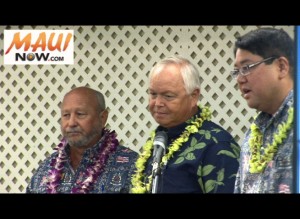VIDEO: Economic recovery on Maui underway, marked by tourism rebound
By Wendy Osher
Maui’s economic picture is marked by an impressive tourism industry rebound, according to First Hawaiian Bank economic advisor and Hawaii Pacific University professor Dr. Leroy Laney, who was the featured speaker at the 36th Annual First Hawaiian Bank Economic Outlook Forum, held at the Maui Beach Hotel in Kahului on Thursday.
[flashvideo file=http://www.youtube.com/watch?v=OIBpE9QYGHM /]

Economist Dr. Leroy Laney (L) presented the latest Maui Economic Outlook at the 36th Annual First Hawaiian Bank Economic Outlook Forum in September 2010. He was joined by fellow economist Dr. Suyderhoud (Center) and FHB Maui Region Supervisor Mitchell Nishimoto (R). Photo by Wendy Osher.
“Barring any unforseen misfortunes, an economic recovery is now underway or at least imminent for the Maui economy, but don’t expect a rapid return to normal,” said Laney.
First Hawaiian Bank Maui Region Supervisor Mitchel Nishimoto said the last 18-24 months have been tough economic times, saying, “it will take time for businesses to rebuild, investors to return to the market, and for consumers to again regain their confidence.” Despite what many of the banks across the nation have experienced, Nishimoto said, First Hawaiian Bank has managed to remain very strong throughout, contributing over $3 million to over 400 non-profit organizations in Hawaii, Guam and Saipan in 2009.
In his presentation on Maui’s Economic Outlook, Laney said Maui easily leads all other counties in tourism recovery in 2010 with both March and May showing particularly impressive gains. “Added flights–from Hawaiian and Alaska Airlines, as well as Canadian carriers WestJet and Air Canada–are helping,” said Laney.
Laney said tourism and construction are two important components of the Hawaii economy that must return to health before sustained recovery emerges. While Maui’s tourism recovery leads the state, Laney said the county’s construction sector lags behind both Honolulu and the Big Island. According to Laney, private building permits on Maui were down nearly 50% in the first quarter of 2010 over the same time a year ago. Some possible causes were attributed to Maui’s 50% affordable housing requirement for new residential development, as well as the ordinance requiring a water permit before construction can commence.
He named residential real estate sales as another impressive growth area for Maui. Laney attributed the positive performance to a combination of greater affordability, declining prices, and record low mortgage rates.
Laney also outlined how Maui is faring in the areas of unemployment, retail, education, and big agriculture.
The job picture on Maui, Laney said, mirrors that of the rest of the state with a bottom emerging. “It won’t be long before overall job gains become consistent,” said Laney. He said Maui, and the state as a whole, is still losing overall jobs, but at a slower rate. The county is doing much better than two years ago when the exit of Aloha Airlines, ATA and two NCL cruise ships began to be felt in the second quarter of 2008, leading to a “very grim year for almost all of 2009.”
In the retail sector, Laney said regional malls are still seeing a mild decline in sales, but tourism retail is strong, reflecting a revival in visitors and their spending.
Laney also evaluated enrollment at the University of Hawaii Maui College where 2010 figures were expected to “break well into the double digits.” UHMC reported a 25% increase in enrollment in 2009, the highest increase in the state, and already exceeds 4,000 students this year. Projects currently underway include the $1.2 million construction of a new Hawaiian Studies Center and the $500,000 redesign of the old science building at the Kahului campus.
As for the big players in the agricultural industry, Laney said recent production figures at Hawaiian Commercial & Sugar Company, “paint a grim picture, but better news is on the way.” According to Laney, HC&S is projected to turn out 170,000 tons of sugar, less than they would like, but better than the 127,000 tons produced in 2009. The gain is being attributed to a delay in harvesting. Laney noted the importance of the industry, saying a shutdown would result in the loss of 800 jobs and result in a, “serious blow to the physical appearance of the Valley Isle.”
As for Maui Land & Pineapple Company, Laney said pineapple took the biggest hit as the company underwent a major reorganization–going from 680 employees to around 200–mostly in golf and retail. He continues to monitor the new Haliimaile Pineapple company, which is aimed mostly at the local market.
“Led by its economic mainstay of tourism, Maui can look forward to better times in the future. Much greater uncertainty would have been attached to a statement like that a year ago,” said Laney.
(PHOTO: Economist Dr. Leroy Laney (L) presented the latest Maui Economic Outlook at the 36th Annual First Hawaiian Bank Economic Outlook Forum on Thursday. He was joined by fellow economist Dr. Suyderhoud (Center) and FHB Maui Region Supervisor Mitchell Nishimoto (R). Photo by Wendy Osher.)









